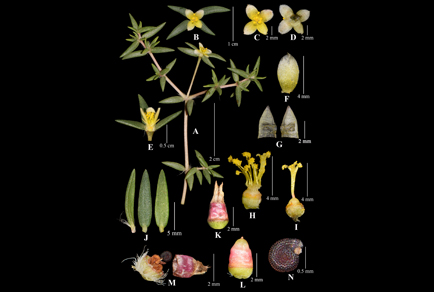Abstract
Portulaca bharat (Portulacaceae) is described and illustrated as a new species from the Aravalli hills (Jaipur, Rajasthan, India). The new species belongs to the subg. Portulaca sect. Neossia having opposite leaf, and it resembles the Linnaean P. quadrifida in having prostrate habit, articulated stem, four petals and flowers encircled by four involucral bracts, but differs in having larger growth habit, oblong-lanceolate and slightly concave leaves, pale yellow flowers becoming creamish-white towards apex, presence of glandular hairs on stamen filaments and thick roots. A detailed morphological description is provided, along with original photos.
References
- Abràmoff, M.D., Magalhães, P.J. & Ram, S.J. (2004) Image processing with ImageJ. Biophotonics international 11 (7): 36–42.
- Geesink, R. (1969) An account of the genus Portulaca in Indo-Australia and the Pacific (Portulacaceae). Blumea 17 (2): 275–301.
- Gilbert, M.G. & Phillips, S.M. (2000) A review of the opposite-leaved species of Portulaca in Africa and Arabia. Kew Bulletin 55 (4): 769–802. https://doi.org/10.2307/4113627
- IUCN (2022) Guidelines for using the IUCN red list categories and criteria, version 15.1. – IUCN Standards and Petitions Committee. Available from: https://www.iucnredlist.org/resources/redlistguidelines (accessed 24 January 2025)
- Linnaeus, C. (1753) Species Plantarum. Vol. 1. Impensis Laurentii Salvii, Holmiae, 560 pp.
- Linnaeus, C. (1767) Mantissa Plantarum. Vol. 1. Impensis Laurentii Salvii, Holmiae, 73 pp.
- Matthews, J.F. & Levins, P.A. (1985) The genus Portulaca in the southeastern United States. Castanea 50: 96–104.
- Nyananyo, B.L. (1987) Taxonomic studies in the genus Portulaca L. (Portulacaceae). Feddes Repertorium 98 (7–8): 399–402. https://doi.org/10.1002/fedr.19870980708
- Rao, M.K.V. (1993) Portulacaceae Juss. In: Sharma, B.D., Sanjappa, M. & Balakrishanan, N.P. (eds.) Flora of India, Vol. 3. Botanical Survey of India, Calcutta, pp. 1–10.
- Sivarajan, V.V. (1980) Taxonomic notes of the genus Portulaca Linn. in India. Journal of Bombay Natural History Society 78: 256–260.
- Tamboli, A.S., Dalavi, J.V., Kadam, S.K., Yadav, S.R., Govindwar, S.P., Choo, Y.S. & Pak, J.H. (2022) Molecular phylogenetic evidence and biogeographic history of Indian endemic Portulaca L. (Portulacaceae) species. Diversity 14 (6): 443. https://doi.org/10.3390/d14060443
- Wadhwa, B.M. & Weerasooriya, A. (1996) Portulacaceae. In: Dassanayake, M.D. & Clayton, W.D. (eds.) A revised handbook to the flora of Ceylon, Vol. 10. Oxford & IBH Publishing Co. Pvt. Ltd., New Delhi, pp. 343–351.
- Wight, R. & Arnott, G.A.W. (1834) Prodromus Florae Peninsulae Indiae Orientalis. Parbury, Allen & Co. London, 480 pp.
- Kokubugata, G., Kato, H., Iamonico, D., Umemoto, H., Ito, T., Nakamura, K., Murakami, N. & Yokota, M. (2015) Taxonomic reexamination of Portulaca boninensis (Portulacaceae) in the Bonin (Ogasawara) Islands of Japan using molecular and morphological data. Phytotaxa 217 (3): 279–287. https://doi.org/10.11646/phytotaxa.217.3.5


